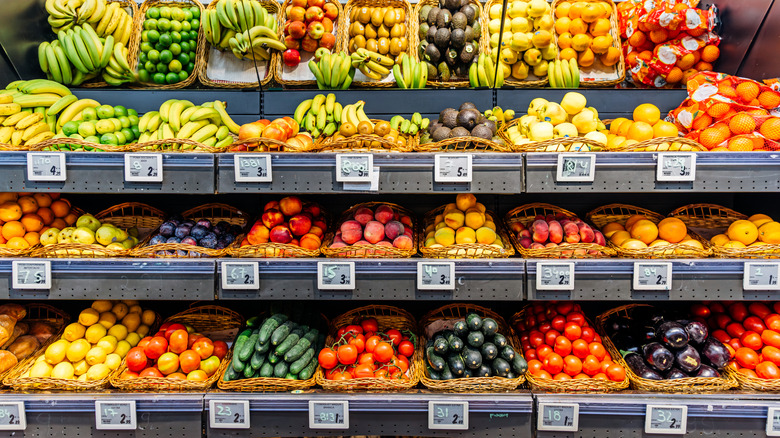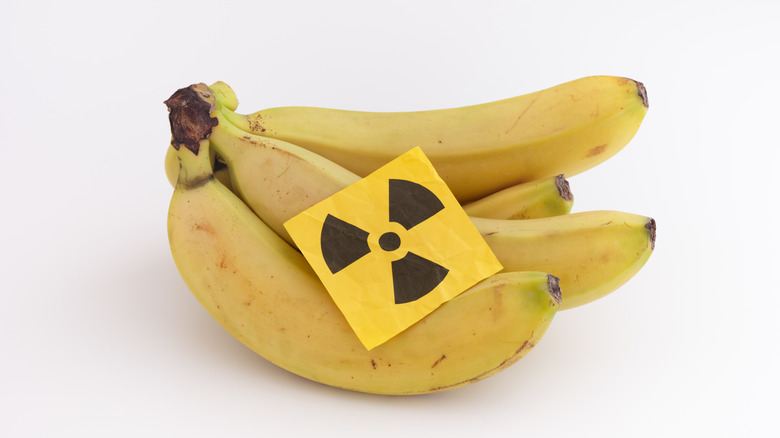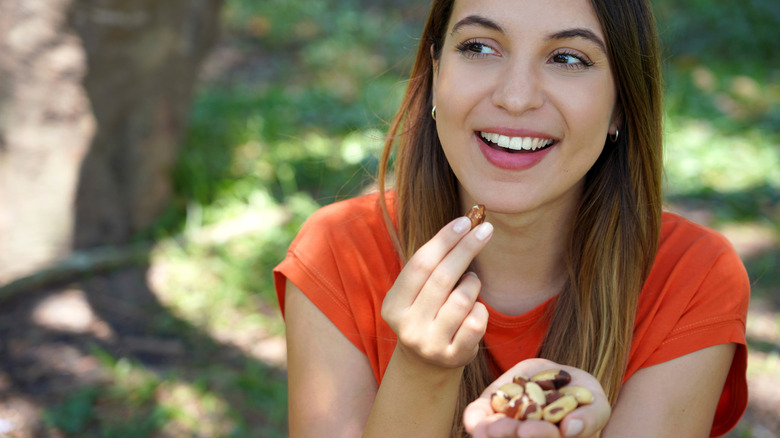This Popular Fruit Is Actually Radioactive (But You'd Have To Eat A Billion Of Them)
Yes, bananas are radioactive — but so are Brazil nuts, carrots, potatoes, beer, peanut butter, and lima beans. In fact, the Earth is filled with radioactive matter, and we're exposed to an unavoidable amount of background radiation all the time from naturally occurring sources. None of this is cause for concern, however. The radioactivity of a food all boils down to the quantity of radioactive isotopes that food contains, as well as the intensity of those radioactive materials' decay. Bananas happen to contain a relatively high amount of potassium, but only a small fraction of that potassium is radioactive.
According to the United States Dietary Guidelines for Americans report, a banana contains, on average, 451 milligrams of potassium. Fortunately for us banana-enjoyers, only 0.012% of naturally occurring potassium is radioactive. Crunching the numbers, that means a single banana has about 0.05 milligrams of radioactive potassium. That's not a lot, but to put your mind at ease even more, consider just how radioactive that so-called radioactive potassium really is.
The majority of naturally occurring potassium is potassium-39, an isotope with 19 protons and 20 neutrons that comprises 93% of all the potassium on Earth. The rest is almost entirely made up of potassium-41, which is also stable. However, the aforementioned 0.012% of naturally occurring potassium that's radioactive is potassium-40, an unstable isotope that can decay and emit cell-damaging radiation in the process. But because potassium-40 has a half-life of 1.3 billion years, the small quantity contained in a banana and the extreme infrequency with which it decays firmly place the beloved yellow fruit in the "safe" category.
What makes a banana radioactive
To a physicist, radiation doesn't carry the scary connotation that the word does in everyday speech. After all, radiation is all around us. Light itself is a form of electromagnetic radiation, as are radio waves and the heat of a warm blanket. It's only when electromagnetic radiation delivers a large burst of energy into our bodies that it becomes a problem. Within the electromagnetic spectrum, photons with the highest-energy charges are called gamma rays, which radioactive isotopes, like potassium-40, can emit when they decay.
Gamma decay is one of three primary types of radioactive decay. The other two types are alpha decay and beta decay. Unlike the massless photons involved in electromagnetic radiation, alpha and beta decay involve the release of particles with masses that can penetrate cells if they are ingested into the body. The radioactive isotope found in bananas, potassium-40, undergoes beta-negative decay to convert one of its neutrons into a proton, releasing a beta particle and transforming the atom into calcium-40. In rare cases, around 11% of the time, potassium-40 decays in the opposite direction by converting one of its protons into a neutron. In such cases, the potassium-40 isotope transforms into argon-40 and releases gamma radiation.
Thus, the potassium-40 found in bananas decays into either calcium or argon, releasing either a beta particle or a gamma ray in the process. It might sound worrying, but a few beta particles or gamma rays aren't going to hurt you. Considering the average adult body already contains 140 grams of potassium, of which 0.0169 grams are the K-40 isotope, ingesting a few milligrams from a banana isn't going to make a difference. Some experts have suggested that you'd have to eat a billion bananas in a single sitting before radiation poisoning could set in.
Other foods can be radioactive, too
The radioactive isotope potassium-40 (K-40) isn't just found in bananas. Any food with high levels of potassium carries proportionate levels of K-40. In fact, there are several common foods that contain potassium at higher concentrations per serving size than bananas. Such fruits include kiwifruit, orange juice, cantaloupe, and guava. Vegetables often contain high potassium levels as well, such as beet greens, white lima beans, potato skins, yams, and spinach. Protein-rich foods like clams, tuna, herring, trout, and raw tofu also have a lot of potassium.
Besides potassium, other radioactive isotopes are present in certain foods at high concentrations. For instance, the Brazil nut is considered the most commonly consumed radioactive food because it contains relatively high levels of radium-226 and radium-228. The radioactivity of those two isotopes, along with the radioactivity of potassium-40, combine together to give the Brazil nut a total radioactivity rating of 6,600 picocuries/kilogram compared to 3,500 pCi/kg in bananas. That's not enough radiation to cause a health hazard, but it has been enough to set off the alarms on early radiation detectors when they were first installed at border crossing stations in the U.S.
The abundance of radioactivity in food isn't proof that the natural world is secretly trying to poison us. Instead, the radioactivity of bananas demonstrates that radioactivity is simply a part of nature. After all, a low exposure to background radiation is unavoidable in our everyday lives. Thus, it's up to us to decide how to manage our exposure to the dangers of radioactivity, and that starts by understanding how such forces operate. Ultimately, bananas are radioactive, but they aren't dangerous.


